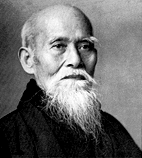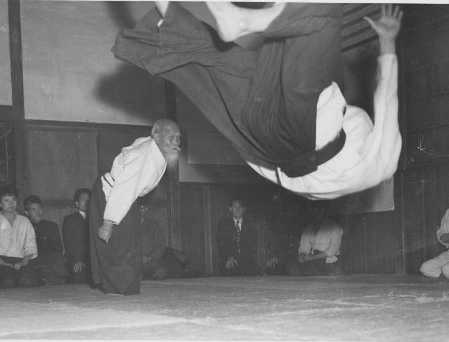
|
"The secret of Aikido is to cultivate a spirit of loving protection for all
things." - Morihei Ueshiba |

|
"The secret of Aikido is to cultivate a spirit of loving protection for all
things." - Morihei Ueshiba |
Aikido is a relatively recent martial art developed in Japan by Morihei Ueshiba (1883-1969), generally referred to as O'Sensei (or "great teacher") among students of Aikido. The word Aikido, which Ueshiba decided upon in 1942, is derived from three Kanji which translate (approximately) as:
- Ai - Harmony/Peace
- Ki - Energy/Spirit
- Do - The Way
Aikido could therefore be translated as "The way of harmonizing energy", though it is difficult to capture the exact meaning of the Kanji, especially "Ki". In a less abstract sense, the techniques of Aikido redirect the aggressive energy of an attacker, causing them to be thrown, immobilized, or otherwise thwarted depending on the skill and intentions of the Aikidoka (a practitioner of Aikido).
The smooth, blending motions of Aikido are often accused of being too "soft" and "impractical" for the purposes of self-defense. Though it is true that it takes a long initial commitment to Aikido for a student to feel that they would be able to use the techniques they have learned to protect themselves from assault, once Aikido has been mastered, it will stay with the student and protect them despite strength, size, or age. Ueshiba is legendary for his prowess even in his 80s, and was still training intently two weeks before his death.
As the quote at the top suggests, it is the opinion of many Aikidoka that the ability to defeat an opponent lies in their ability to protect both their opponent and themselves from harm while still being victorious. Many Aikido techniques require only minor adjustments from the way in which they are practiced for them to become crippling or even lethal. (The well known family of "iriminage" techniques are closely related to a neck break.) The mark of a true master, however, is the ability to use these techniques to their full effectiveness with minimal harm.
"In Aikido, we're not out to break anything. We just rearrange it for a little while."
-- Sensei Jim Walsh

Adopted from previous webpage version by Byron Holtz